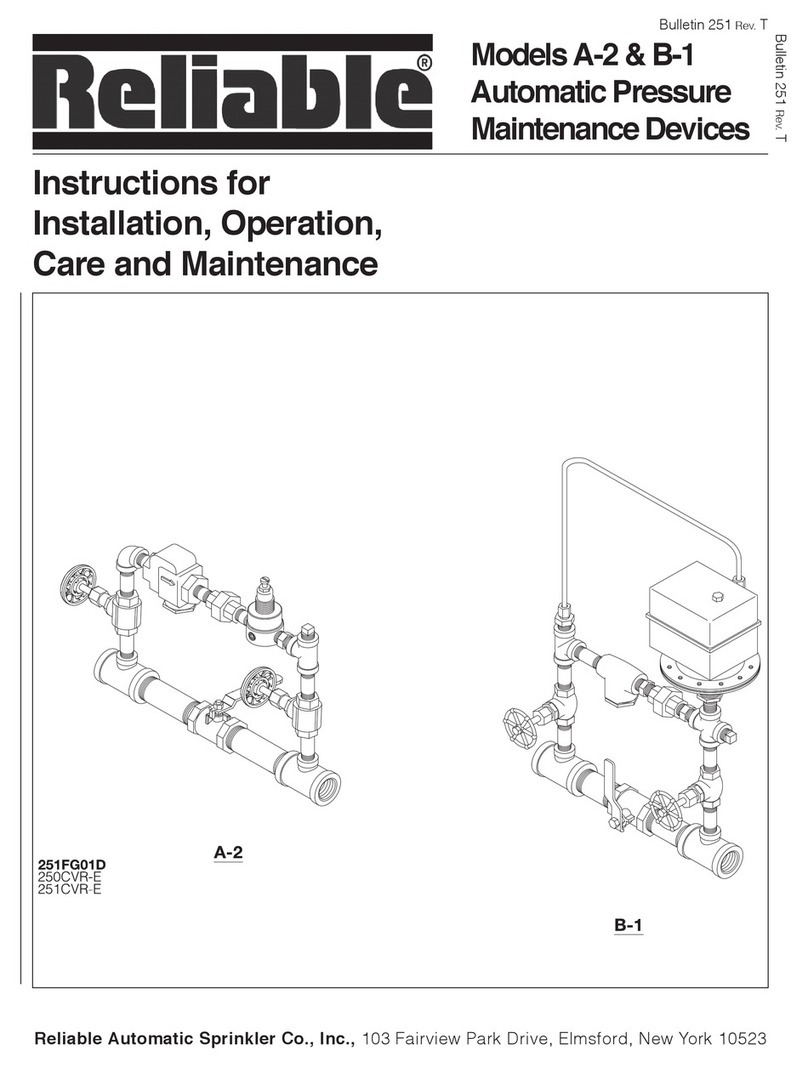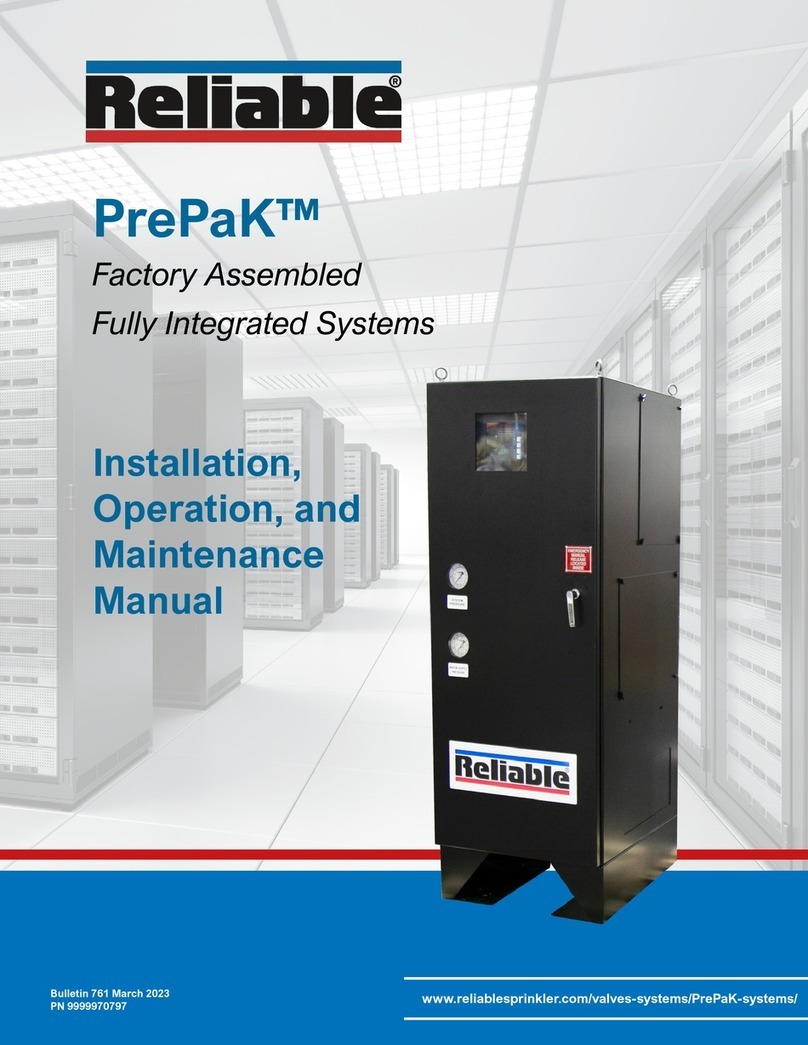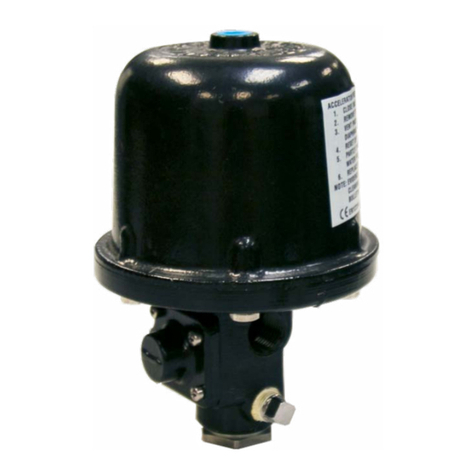Reliable DDX PrePaK Maintenance manual

Reliable Automatic Sprinkler Co., Inc., 103 Fairview Park Drive, Elmsford, New York 10523
Model DDX PrePaK™, Type F
Preaction System
2” (50mm), 21
/
2” (65mm), 3” (80mm),
4”(100mm),6”(150mm)&8”(200mm)
Bulletin 747 May 2021
Bulletin 747 May 2021
Instructions for
Installation, Operation,
Care and Maintenance
8 psi - 24 psi (0.6 bar - 1.7 bar) Recommended Supervisory Pressure
Double Interlock
Electric/Pneumatic Release
General Description
The Reliable Type F Model DDX PrePaK system is a com-
pletely self-contained, supervised preaction system that can be
readily installed within a floor space of less than 7.5 square
feet ( 0.70 square meters) (not including door swing). Refer to
Fig. 1 for cabinet dimensions. Installation of the PrePaK system
(not including exterior devices, i.e., detectors and alarm bells),
requires just three piping connections. These connections are
the water supply, the sprinkler system and the drain. Refer-
ence locations of these piping connections are shown in Fig.
1. Two electrical supply connections are required. Note: The
Model DDX PrePaK system is available with an optional 115V
VAC (60Hz) air compressor and an optional Potter Model PFC-
4410-RC Releasing/Control panel wired for a 120 VAC (50Hz)
or 220 VAC (50/60Hz) power supply.
Full assembly drawings for the units are available on the Reli-
able Automatic Sprinkler Company website (www.reliablesprin-
kler.com)
The Reliable Type F PrePaK system utilizes an optional Potter
Model PFC-4410-RC Releasing/Control Panel. This fully pro-
grammable, microprocessor-based releasing panel is Under-
writers Laboratories, Inc. Listed and is in compliance with NFPA
13 and NFPA 72. Because the PFC-4410-RC is totally zone
and output programmable, the Reliable Type F PrePaK system
can be utilized in many different preaction applications without
having to rewire any of the factory installed devices. Once the
previously described connections are completed, the 24 VDC
detectors, output devices, and relay contacts may be connect-
ed to achieve the desired system implementation.
The Type F PrePaK system is designed specically for double
interlock applications. Reliable double interlock preaction sys-
tems are designed for water sensitive areas that require protec-
tion from inadvertent water flow into the sprinkler system piping.
The major benets of a double interlock preaction System,
when compared with a wet pipe system, are as follows:
A. A re alarm sounds prior to the flow of water from a
sprinkler, which may enable extinguishment of the
re by handheld means before the operation of any
sprinkler occurs.

2.
B. An annunciator signals whenever the integrity of pip-
ing or sprinklers is accidentally or intentionally dis-
turbed; however, no water flow occurs at that time.
C. Detection and notication of a re condition are pro-
vided by re detectors, without the delay associated
with water delivery time in the event of a re. Note
that with a wet pipe system, the re alarm is delayed
until after water has begun flowing from and oper-
ated sprinkler.
To flow water into the system piping of a Type F double inter-
lock preaction system, two events must take place:
1) A re detection device must detect heat and/or smoke
thereby causing the releasing/control panel to energize
the normally-closed solenoid valve.
2) The sprinkler system piping must discharge enough
supervisory air for the Model LP Dry Pilot Actuator to
operate. This is generally the result of a sprinkler oper-
ating due to re.
In the event that the system piping is ruptured, or a sprinkler
head is accidentally opened, the Model LP Dry Pilot Actuator
will open and a low system air pressure alarm will sound. The
Model DDX Deluge Valve, however, will not be released to flow
water since the solenoid valve still remains closed. Conversely,
in the event of a false detection signal, the releasing/control
panel will activate an alarm, but the Model DDX Deluge Valve
will not flow water due to the fact that the Model LP Dry Pilot
Actuator remains closed.
When using the Reliable Type F PrePaK system in double
interlock applications the sprinkler system is pressurized (su-
pervised) with air provided by the optional factory-installed air
compressor (or on-site Nitrogen supply) and is monitored by
a system pressure switch. If Nitrogen is used as the supervi-
sory gas, an optional Nitrogen Kit is available. This kit contains
a regulator and an additional pressure switch that is used to
monitor any low pressure conditions that may arise due to hav-
ing a limited Nitrogen supply. The optional factory-installed air
compressor can be utilized for make-up air until the Nitrogen
supply can be replenished.
Note: Compressed air is not to be considered as dry air and
may create ice plugs in the sprinkler system piping.
A Model B Hydraulic Manual Emergency Releasing station is
standard equipment in the Type F PrePaK system. It consists of
an aluminum nameplate mechanically attached to a ball valve.
The valve handle in its OFF position is guarded against acci-
dental turning to the ON position (and system discharge) by a
nylon cable tie provided with the PrePaK system assembly. The
cable tie is designed to allow, in case of an emergency, forceful
turning of the valve handle to the ON position.
Listings and Approvals
1. Underwriters Laboratories, Inc. Listed and Certied for
Canada* (cULus) as an assembled unit in the “Special
System Water Control Valves Assembled Units” cat-
egory, (VKYL).
*The system’s pressure switches must be specied to
meet Canadian requirements. This option is available.
2. Factory Mutual Approved as a Refrigerated Area Sprin-
kler System for use in refrigerated rooms or buildings.
Refrigerated area sprinkler systems are FM Approved
as complete systems. Systems are FM approved for
use with thermal detectors and Class A detector wiring
only.
3. Factory Mutual Approved for applications where FM
Global Data Sheets allow the use of double-interlock
preaction systems.
Note: Although PrePaK system units are UL Listed, custom
built units are sometimes supplied upon request. The com-
ponents within these special units maintain their individual
Listings/Approvals, whereas the assembled units do not.
PrePaK system units are also available without their Potter
PFC-4410-RC Releasing/Control Panel and Air Compressor.
These units will still retain their Listings/Approvals, however
the installing contractor should make sure that any remote
controlled Releasing/Control Panels used with these units are
Listed/Approved and programmed to handle the required se-
quence of operation necessary to operate the automatic sprin-
kler system. Any unauthorized modication or addition made
on-site to a factory-built Listed/Approved unit will void the List-
ing/Approval. Such modications or additions may void the
unit’s warranty as well. Consult Reliable’s Technical Services
Department before proceeding with any such modications or
additions.
Technical Data
1. The Reliable Type F Model DDX PrePaK system is rated
for a minimum water supply pressure of 20 psi (1.4 bar)
and a maximum water supply pressure of 250 psi (17.2
bar). Note: 1 bar = 100 kPa.
2. Friction loss, expressed in equivalent length of Sched-
ule 40 pipe and based on Hazen-Williams Formula is:
System Size: Equivalent Length
2” (50mm) 19.4 ft (1.3 m)
2½” (65mm) 24.5 ft (1.8 m)
3” (80mm) 28.9 ft (3.8 m)
4” (100 mm) 32.8 ft (17.7 m)
6” (150 mm) 54.7 ft (21.8 m)
8" (200mm) 79.3ft (24.2m)
These values account for the Model DDX Deluge Valve,
supply manifold tee, butterfly control valve, and small pipe/
manifold located directly above Model DDX Deluge Valve.
3. Shipping Weight:
System Size Weight
2” (50 mm), 2½” (65 mm)
& 3” (80 mm)
554 lb. (252 kg)
4” (100 mm) 710 lbs (322 kg)
6” (150 mm) 800 lbs (363 kg)
8" (200mm) 1350lbs (531kg)
4. Please reference Figure 1 for dimensions.

3.
Fig. 1

4.
Hydrostatic Testing of DDX Valves and DDX
Systems
As required by NFPA 13, re sprinkler systems with working
pressures up to and including 150 psi are to be hydrostatically
tested at a water pressure of 200 psi. Fire sprinkler systems with
working pressures above 150 psi are required to be hydrostati-
cally tested at 50 psi above the system working pressure. In addi-
tion to the hydrostatic tests described above, dry pipe and double
interlock preaction systems require an additional low pressure air
test.
In some cases, hydrostatic testing (in accordance with the NFPA
13 requirements noted above) will result in pressures that exceed
the working pressure of the valve and trim kit for the two-hour test
period. The valve and applicable trim kit have been tested, ap-
proved and listed under these conditions and as such, hydrostatic
testing in accordance with NFPA 13 is acceptable. In addition, the
clapper can remain in the closed position and the trim kit need not
be isolated, as each has been designed to withstand hydrostatic
testing as required by NFPA 13.
Hydrostatically testing the valve and trim to pressures higher
than their rating is limited to the hydrostatic test as referenced by
NFPA13. It does not address the occurrence(s) of a “water ham-
mer” effect, which can indeed damage the valve. A “water ham-
mer” in the water supply piping of the valve can create pressures
in excess of the rated pressure and should be avoided by all nec-
essary means. This condition may be created from improper re
pump settings, underground construction work, or an improper
venting of trapped air in the water supply piping.
System Air / Nitrogen Pressure Requirements
The Model DDX Type F PrePaK system includes gauges indi-
cating the pneumatic and water pressures of Model LP Dry Pilot
Actuator. Table A species the air or nitrogen pressure level to be
applied to the Actuator. The factory installed Pressure Mainte-
nance Device in the unit automatically provides adequate makeup
air or nitrogen flow to maintain supervisory pressure with normal
leakage for the system piping, while restricting the flow of makeup
air or nitrogen to allow for system operation. Please note that
when the optional Model B1 Accelerator is to be utilized to expe-
dite water-delivery time, the pneumatic pressure must be not less
than 15 psi (1.0 bar).
The following is a list of Technical Data Bulletins which de-
scribe the valves and devices which are used in the system:
Device Reliable Bulletin #
(unless otherwise noted)
Model DDX Deluge Valve Reliable Bulletin 519
Type F Double Interlock Preaction Trim Reliable Bulletin 751
Low Air Pressure Switch Potter, 5401564
Alarm Pressure switch Potter, 5400928
Nitrogen Pressure Switch Potter, 5400930
Mechanical Sprinkler Alarm Reliable Bulletins 612/613
Releasing Control Panel Potter Manual #5403550
Fire Alarm Devices Reliable Bulletin 700
Desiccant Dryer Wilkerson Catalog 9EM-TK-190-4
The following table provides a quick reference to the various
programs (found in this bulletin and the Potter Manual
#5403550) that may be utilized with a Type F PrePaK system:
Desired Application Program
Single Interlock,
Single Zone
Potter Program #6
(Factory Setting)
Single Interlock,
Cross-Zoned Potter Program #7
Note: The Model DDX Type F PrePaK Double Interlock Preaction
system utilizes a solenoid controlled by single interlock programming
in conjunction with a pneumatic (mechanical) actuator.
Installation Requirements
The automatic sprinklers, releasing devices, re detec-
tion devices, manual pull stations, and signaling devices
which are utilized with the Reliable Model DDX Type F
PrePaK system must be UL and/or ULC Listed or FM Ap-
proved, as applicable.
The steel enclosure and all the interconnecting piping
must be located indoors in a readily visible and acces-
sible location and in an area that can be maintained at a
minimum temperature of 40°F (4°C). Note: Heat tracing is
not permitted. The solenoid valve is operated and super-
vised by the Potter Model PFC-4410-RC Releasing Control
Panel. Details on the electrical connections of this system
to the Potter Panel can be found in the Potter Manual
#5403550, Installation, Operation and Instruction of PFC-
4410-RC Releasing Control Panel (this manual is included
with other pertinent manuals and shipped inside the en-
closure). This panel is fully zone and output programmable
and may be adapted to several applications. Hydrostatic
Testing of DDX Valves and DDX Systems.
Optional Seismic Kit
Reliable part number 6501200041 (25” x 28” cabinet for 2”
-4” systems without nitrogen generator) and 6501200042 (30”
x 33” cabinet for 6” and 8” systems, and all units with nitrogen
generator) are seismic upgrade kits required to make the Reli-
able PrePaK OSHPD compliant. One kit is required for each
PrePaK (reference Caution Sheet 331).

5.
Note: During system set-up, a higher pneumatic pressure
may be required in order to properly set the Model LP Dry
Pilot Actuator. The dew point of the air supply must be main-
tained below the lowest ambient temperature to which the
preaction system will be exposed. Introduction of moisture
into the system piping exposed to freezing temperatures
can create ice blockage which could prevent proper system
operation. As a minimum, the supply of air should be taken
from the area of lowest temperature within the protected
area. The air supply system must be carefully designed to
prevent plugging by frost deposits. Special requirements,
such as those in FME&R’s “Installation Guidelines for Refrig-
erated Storage” may need incorporated.
Nitrogen used in refrigerated area systems minimizes a pos-
sibility of ice build-up and blockage inside the system piping that
could inhibit proper system operation. The dewpoint of nitrogen
compressed to 20 psig (1.4 bar) pressure is -46°F (-43.3°C),
and -52°F (-46.7°C) when compressed to 10 psig (0.7 bar).
High-pressure nitrogen cylinders can typically be rented from a
local source, with rental fees varying by supplier and cylinder
sizes. The calculated nitrogen supply in lbs (kg) to pressurize
various system capacities to 10 psi (0.7 bar) at different freezer
temperatures is shown in Table B.
A Nitrogen Kit is available as an option, for installations where
nitrogen is used as the supervisory gas. A “low-nitrogen” LED
is mounted onto the door of the Potter Model PFC-4410-RC Re-
leasing/Control Panel. It will illuminate when the nitrogen pressure
switch detects that the available nitrogen supply falls to 100 psi
(6,9 bar). The nitrogen source should be replaced promptly upon
operation of the pressure switch. If the nitrogen supply is not re-
placed, the entire amount of make-up air will come solely from the
unit’s air compressor (if installed).
Table B
System
Capacity
Gal. (L)
Freezer Temperature Approx.
Fill Time
(min.)*
20°F
(-6.7°C)
0°F
(-18°C)
-20°F
(-29°C)
-40°F
(-40°C)
-60°F
(-51°C)
250
(946)
1.90
(.86)
1.90
(.86)
2.00
(.90)
2.10
(.95)
2.20
(1.00) 1
500
(1891)
3.64
(1.65)
3.80
(1.72)
4.00
(1.81)
4.20
(1.91)
4.40
(2.00) 2
750
(2840)
5.50
(2.50)
5.70
(2.60)
6.00
(2.72)
6.30
(2.86)
6.60
(3.00) 3
1,000
(3785)
7.30
(3.30)
7.60
(3.44)
8.00
(3.62)
8.33
(3.78)
8.80
(4.00) 4
Note: To obtain required nitrogen supply (lbs.) for 15 psi (1.0 bar)
or 22 psi (1.5 bar), multiply the tabulated values by a factor
of 1.5 or 2.2 respectively.
(1 bar = 100 kPa)
* When lled with the Rapid Air – Fill Shutoff Valve open.
If the air compressor in the Model DDX Type F PrePaK sys-
tem is used to initially ll the sprinkler system with air, the steel
enclosure door should remain open to provide maximum intake
air flow to the air compressor. The air compressor is connected
to a storage tank. This tank functions as a reservoir, providing
make-up air to compensate for small, intermittent leaks in the
sprinkler system. It should be noted that signicant leaks may
overburden this storage tank, thereby causing the air compres-
sor to continuously cycle on and off.
The factory-installed system air pressure switch may need
on-site adjustment to correspond with the air pressure values
found in Table A. Adjustment, if required, should be made ac-
cording to Potter Bulletin 5401564 included with the switch.
System Electrical Requirements
All releasing, alarm, and detection devices in the Reliable
Model DDX Type F PrePaK system are supervised by a Potter
Model PFC-4410-RC Releasing Control Panel. All of the termi-
nals are translated to a water-tight terminal box mounted on
the interior of the enclosure. All eld wiring is connected to this
terminal box. Note: The EOL (End of Line) resistors have also
been relocated.
The Reliable Model DDX PrePaK system is delivered with six
factory-installed electrical devices. They consist of the following:
1. A system air pressure switch, which is used to monitor
sprinkler piping.
2. An alarm pressure switch, which indicates an actuation of
the deluge valve.
3. A normally-closed, releasing solenoid valve, which is used
to actuate the deluge valve.
4. A 1/2 HP (2”, 2-1/2”, & 3” valve), 1 HP (4” valve), or 1-1/2
HP (6” & 8” valve) air compressor with tank.
5. A supervised butterfly (main control) valve (Note: A system
side butterfly valve is available as an option).
6. A release control disable switch (RCDS) which is used to
disable the solenoid valve for test purposes.
Water Pressure psi (bar) System Air or Nitrogen Pressure
psi (bar)
Maximum Not Less Than
20 (1.4) 8 (0.6)
30 (2.1) 10 (0.7)
50 (3.4) 12 (.8)
75 (5.2) 13 (.9)
100 (6.9) 15 (1.)
125 (8.6) 16 (1.1)
150 (10.3) 17 (1.2)
175 (12.1) 18 (1.2)
200 (13.8) 19 (1.3)
225 (15.5) 21 (1.4)
250 (17.2) 22 (1.5)
275 (19.0) 23 (1.6)
300 (20.7) 24 (1.7)
Table A
Notes:
1. Supervisory air or nitrogen pressure should not exceed 30 psi (2.1
bar). Excess pressure may result in damage to the actuator.
2. Fastest valve operation is achieved with supervisory air or nitrogen
pressure indicated; however, pressure must never be less than the
minimum specified in the table above.
3. Air maintenance devices that maintain a constant pressure are
recommended; however, if a tank-less compressor is used, the
“compressor on” setting of the pressure switch must never be lower
than the minimum pressure in the table above.

6.
The factory electrical connections of these devices, along
with information on the connection of detection devices (initiat-
ing zones 1 and 2), signaling devices, and supervisory outputs
to the Potter PFC4410-RC Releasing Control Panel are includ-
ed in this bulletin. The power supply, standby emergency power
supply, battery charger and rectier circuitry are all contained
within the PFC4410 panel. Batteries that provide 90 hours of
standby power are provided with the panel. For additional in-
formation and detailed wiring diagrams, please refer to Potter
Manual #5403550 (Installation, Operation and Instruction of
PFC4410-RC Releasing Control Panel).
Note: In order for the solenoid valve to maintain a warranty it must
remain sealed as it came from the factory. If there are concerns
about the valve’s internal components, immediate replacement is
recommended.
System Operation (Double Interlock)
To fully activate (discharge water from) the Reliable Model
DDX Type F PrePaK system, a re detection device must ac-
tivate and pneumatic pressure must be lost from the sprinkler
system piping (normally from the activation of one or more re
sprinklers).
When the system is properly set for service, the water sup-
ply pressure simultaneously acts on both the underside of the
deluge valve’s clapper and on the valve’s push rod by means
of the pressurized push rod chamber. The resultant pressure
force acting on the push rod, in unison with the mechanical ad-
vantage of the deluge valve lever, is more than sufcient to hold
the valve clapper in the closed position against the water supply
pressure.
Energizing the releasing solenoid valve is only one of the
events required towards opening the deluge valve. Air pres-
sure in the sprinkler system must also be reduced to a level
low enough to activate the Model LP Dry Pilot Actuator. Both
of these events allows the deluge valve’s push-rod chamber to
be vented to drain through its outlet. Since the push-rod cham-
ber pressure cannot be replenished through the inlet restriction
as rapidly as it is vented, the pressure falls rapidly. When the
push-rod chamber pressure drops below one-third of the wa-
ter supply pressure, the force acting beneath the valve clapper
becomes greater than the push-rod force acting on the lever
which causes the clapper to open. Refer to Reliable Technical
Bulletin 751 for further details.
Once the clapper has opened, the lever acts as a latch, pre-
venting the clapper from returning to the closed position. Water
from the supply flows through the deluge valve into the system
piping and also through the alarm outlet to activate water flow
alarm devices. Note that the solenoid valve will be maintained
open by the Potter Model PFC-4410-RC Releasing/Control
Panel latching feature until it is reset for operation.
After system shutdown and draining, the Model DDX Deluge
Valve clapper is easily reset without special tools using the ex-
ternal reset feature. Restore detection devices by resetting or
replacing any operated device. Once detection devices are re-
stored the system can be reset (see Resetting Model DDX Type
F Double Interlock Preaction System).
Resetting Model DDX Type F Double Interlock
Preaction System
1. Close the valve controlling water supply to the Deluge
Valve and close the air or nitrogen supply to the sprinkler
system.
2. Close the pushrod chamber supply valve.
3. Open main drain valve and drain system.
4. Open all drain valves and vents at low points throughout
the system, closing them when flow of water has stopped.
Open the Model B Manual Emergency Station to relieve
pressure in the pushrod chamber of the Deluge Valve.
5. With the alarm line valve open, push in the plunger of
ball drip valve, forcing the ball from its seat, and drain the
alarm line.
6. With the Model B Manual Emergency Station open,
push in and rotate the Deluge Valve’s external reset knob
counterclockwise (when facing the valve), until you hear a
distinct noise indicating that the clapper has reset. Note:
The reset knob can be rotated only while pressure in the
pushrod chamber is vented to atmospheric conditions (0
psig).
7. Inspect and replace any portion of the detection system
and/or sprinkler system subjected to re conditions.
8. Open the pushrod chamber supply valve and allow wa-
ter to ll the pushrod chamber. Close the Model B Manual
Emergency Station.
9. Purge all air from the actuation piping: Open the so-
lenoid valve by operating a detector or an electric manual
emergency station. Note that the Model LP Dry Pilot Actua-
tor should also be open since there is no pneumatic pres-
sure on the system.
10. While water is flowing through the solenoid valve AND
the actuator, cause the actuator to close rst by applying air
or nitrogen pressure to the system.
11. Open the air or nitrogen supply quick ll valve to restore
supervisory pressure in the sprinkler system and close the
dry pilot actuator. Allow the pressure to build to the level
specied in Table A, then set the pneumatic supply to au-
tomatic operation. (Note: To build supervisory air pressure
in the sprinkler system, it may be necessary to temporarily
close the main drain valve and the alarm line valve until air
pressure has built up to the recommended level.)
12. After the Model LP Dry Pilot Actuator has been set,
close the solenoid valve by resetting the release control
panel. (All detectors and manual pull stations must be in a
normal state before the panel can be reset.)
Note: It is important that the piping between the solenoid
valve and the dry pilot actuator is lled with water and not
air. This is accomplished by closing the dry pilot actuator
FIRST while water is flowing through the device and closing
the solenoid valve only AFTER the actuator is completely
set.

7.
13. Open the alarm line valve. Verify the main drain valve
is open. Slightly open the main valve controlling water sup-
ply to the Model DDX Deluge Valve, closing the main drain
valve when water flows. Observe if water leaks through the
ball drip valve. If no leak occurs, the Deluge Valve clapper is
sealed. Slowly open the main valve controlling water supply
until fully open and verify that it is properly monitored.
14. Verify that the pushrod chamber supply valve and alarm
line valve are open. The pushrod chamber supply valve
must remain open when the Deluge Valve has been reset,
to maintain water pressure in the pushrod chamber.
15. Verify that the Model B Manual Emergency Station is
secured in the OFF position with the appropriate nylon tie.
Inspection and Testing
1. Water supply — Conrm that valves controlling water
supply to the Deluge Valve are opened fully and properly
monitored.
2. Alarm line — Conrm that the alarm line valve is open
and remains in this position.
3. Other trim valves — Conrm that the pushrod chamber
supply valve is open, as well as all pressure gauge valves.
The main drain valve, condensate drain valve, and alarm
test valve should be closed.
4. Ball drip valve — Push in on the plunger to be sure ball
check is off its seat. If no water appears, the Deluge Valve
water seat is tight. Inspect the bleed hole on the underside
of the pushrod chamber for leakage.
5. Dry pilot trim — Inspect air pressure for conformance to
Table A.
6. Releasing device — Check outlet of the releasing de-
vice (i.e., solenoid valve and hydraulic manual emergency
station) for leakage. Also verify that tubing drain lines from
releasing devices are not pinched or crushed which could
prevent proper releasing of the Deluge Valve.
7. Testing alarms — Open the alarm test valve permitting
water from the supply to flow to the electric sprinkler alarm
switch and to the mechanical sprinkler alarm (water motor).
After testing, close this valve securely. Push in on the plung-
er of ball drip valve until all water has drained from the alarm
line.
8. Operational test — Open the Model B Manual Emer-
gency Station. Alternatively, operate the electrical detection
system and deplete pneumatic pressure from the sprinkler
system.
Note: AN OPERATIONAL TEST WILL CAUSE THE DEL-
UGE VALVE TO OPEN AND FLOW WATER INTO THE
SPRINKLER SYSTEM.
9. Secure the Model B Manual Emergency Station in the
OFF position with nylon tie after Deluge Valve is reset.
Testing Detection System Without Operating
Deluge Valve
1. Close the valve controlling water supply to the deluge
valve and open the main drain valve.
2. Verify that valve supplying hydraulic pressure to the pis-
ton/pushrod chamber is open, allowing water to enter the
pushrod chamber.
3. Operate the electrical detection system and deplete
pneumatic pressure from the sprinkler system.
4. Operation of the detection combined with loss of pneu-
matic pressure must result in a sudden drop of water pres-
sure in the pushrod chamber, as indicated by the pressure
gauge on the hydraulic release trim.
5. Reset the valve per the reset instructions.
Maintenance
The owner is responsible for maintaining the re protection
system in proper operating condition. Any system main-
tenance or testing that involves placing a control valve or
detection/control system out of service may eliminate the
re protection that is provided by the re protection system.
The Reliable Model DDX valve and associated equipment
shall periodically be given a thorough inspection and test.
NFPA 25, “Inspection, Testing, and Maintenance of Water
Based Fire Protection Systems,” provides minimum mainte-
nance requirements. System components shall be tested,
operated, cleaned, and inspected at least annually, and
parts replaced as required. Replace any components found
to be corroded, damaged, worn, or non-operable. Increase
the frequency of inspections when the valve is exposed to
corrosive conditions or chemicals that could impact materi-
als or operation of the assembly.
If face plate is removed during maintenance, torque face
plate bolts to the following values during re-installation:
35 ft-lbs. (47 N-m) for 2” through 4” valves
70 ft-lbs. (95 N-m) for 6”-8” valves
Draining Excess/Condensate Water from the
System
1. Notify the owner and monitoring company that mainte-
nance is being performed on the system.
2. Close the main water control valve.
3. Open the Main Drain Valve.
4. Open the Condensate Drain Valve until all water has
drained.
5. Close Condensate Drain Valve.
6. Partially open the Main Water Control Valve.
7. Slowly close the Main Drain Valve.
8. Fully open the Main Water Control Valve.
9. Notify the owner and monitoring company that the sys-
tem has been returned to service.

8.
SOLENOID VALVE INSPECTIONS, TESTS AND
MAINTENANCE
WARNING: THE OWNER IS RESPONSIBLE FOR MAIN-
TAINING THE FIRE PROTECTION SYSTEM IN PROPER
OPERATING CONDITION. ANY SYSTEM MAINTENANCE
OR TESTING THAT INVOLVES PLACING A CONTROL
VALVE OR DETECTION SYSTEM OUT OF SERVICE MAY
ELIMINATE THE FIRE PROTECTION OF THAT SYSTEM.
PRIOR TO PROCEEDING, NOTIFY ALL AUTHORITIES
HAVING JURISDICTION. CONSIDERATION SHOULD BE
GIVEN TO EMPLOYMENT OF A FIRE PATROL IN THE AF-
FECTED AREA.
WARNING: PRIOR TO OPERATING THE SOLENOID
VALVE, BE SURE TO CLOSE THE SYSTEM CONTROL
VALVE TO AVOID UNINTENTIONAL OPERATION OF THE
DELUGE VALVE
1. Inspections: It is imperative that the system be inspect-
ed and tested in accordance with NFPA 25 on a regular
basis. The frequency of the inspections may vary due to
contaminated water supplies, corrosive water supplies,
or corrosive atmospheres. In addition, the alarm devices,
detection systems, or other connected trim may require a
more frequent schedule. Refer to the system description
and applicable codes for minimum requirements.
2. The valve must be inspected at least monthly for cracks,
corrosion, leakage, etc., cleaned and replaced as neces-
sary.
3. If leakage is suspected through the solenoid valve, it
should be replaced.

Fig. 2
Note: Trim valve location is common to wet pilot line,
dry pilot line, and electric release systems.
9.

10.
Fig. 3

11.
Fig. 4

12.
Fig. 5

13.
Fig. 6

14.
Fig. 7

15.
Fig. 8 — Wiring Diagram

16.
Fig. 9 — Wiring Diagram

17.
POTTER PROGRAM #6
OUTPUTS
ZONES
Supervisory 2 (1)
#1
Conventional (2)
#2
Conventional(2)
#3
Waterflow
#4
Low Air Supervisory
#1 ALARM X
#2 WATERFLOW X
#3 SUPERVISORY X X
#4 RELEASE X
Single Interlock, Single Detection Zone
Potter Program #6
1. Apply power to panel.
2. Slide the program switch down.
3. Press the FUNCTION button until the display reads
“PASSWORD=000.”
4. To enter a password, press the SELECT button until the
proper number is displayed above the “^” symbol; then
press the SET button to move to the next digit. After
entering the third number the display will change. (All
panels are shipped with a “000” password.)
5. Press the FUNCTION button until the display reads
“PROGRAM ##.” (the second “#” character refers to
the current program number between “0” and “24”).
6. Press the SELECT button until the display reads “PRO-
GRAM #6.”
7. Press the SET button
8. The panel is completely programmed except for the
custom banner and zone messages. Slide the program
switch back up.
INPUTS: 1 conventional zone, 1 manual release zone, 1 waterflow zone, 1 low air zone, 1 supervisory zone.
OUTPUTS: 1 general alarm bell, 1 waterflow bell, 1 supervisory bell, 1 solenoid release circuit.
OPERATION: Activation of either conventional zone (or operation of the manual pull station within the PrePaK system
cabinet) will operate the solenoid release circuit and the general alarm bell. Activation of the waterflow zone
will operate the waterflow bell. Activation of either the low air zone or the supervisory zone will operate the
supervisory bell. When either Zone #1 or #2 is in alarm, Output #1 (general alarm) and Output #4 (solenoid
release) will operate. When Zone #3 is in alarm, Output #2 (waterflow bell) will operate. When either Zone
#4 or the supervisory zone is activated, Output #3 (supervisory bell) will operate.
Note:
(1) The Butterfly valve in the PrePaK system assembly is connected to Supervisory 2 input of the Potter PFC-4410RC Re-
leasing/Control panel
(2) The emergency manual release within the PrePaK system cabinet is wired into the conventional detection zones 1 and 2, and is de-
signed to release the solenoid for setup and testing purposes.
For additional Information, please refer to the “Installation, Operation, and Instruction Manual” for the Potter
PFC4410-RC Releasing Control Panel (provided with the unit).

Single Interlock, Cross Zoned Detection
Potter Program #7
1. Apply power to panel.
2. Slide the program switch down.
3. Press the FUNCTION button until the display reads
“PASSWORD = 000.”
4. To enter a password, press the SELECT button until the
proper number is displayed above the “^” symbol; then
press the SET button to move to the next digit. After
entering the third number the display will change. (All
panels are shipped with a “000” password).
5. Press the FUNCTION button until the display reads
“PROGRAM ##.” (the second “#” character refers to
the current program number between “0” and “24”).
6. Press the SELECT button until the display reads “PRO-
GRAM #7.”
7. Press the SET button.
8. The panel is completely programmed except for the
custom banner and zone messages. Slide the program
switch back up.
INPUTS: 2 conventional zones (cross-zoned), 1 waterflow zone, 1 low air zone, 1 supervisory zone.
OUTPUTS: 1 general alarm bell, 1 waterflow bell, 1 supervisory bell, 1 solenoid release circuit.
OPERATION: Activation of both conventional zones at the same time (or operation of the manual pull station within the
PrePaK system cabinet) will operate the solenoid release circuit and the general alarm bell. Activation of
either conventional zone will operate the general alarm bell. Activation of the waterflow zone will operate the
waterflow bell. Activation of either the low air zone or the supervisory zone will operate the supervisory bell.
When either Zone #1 or #2 is in alarm, Output #1 (general alarm) will operate. When Zones #1 and #2 are
in alarm at the same time, Output #4 (solenoid release) and Output #1(general alarm) will operate. When
Zone #3 is in alarm, Output #2 (waterflow bell) will operate. When either Zone #4 or the supervisory zone
is activated, Output #3 (supervisory bell) will operate.
Note:
(1) The Butterfly valve in the PrePaK system assembly is connected to Supervisory 2 input of the Potter PFC-4410RC Re-
leasing/Control panel
(2) The emergency manual release within the PrePaK system cabinet is wired into the conventional detection zones 1 and 2, and is de-
signed to release the solenoid for setup and testing purposes.
For additional Information, please refer to the “Installation, Operation, and Instruction Manual” for the Potter
PFC4410-RC Releasing Control Panel (provided with the unit).
POTTER PROGRAM #7
OUTPUTS
ZONES
Supervisory 2 (1)
#1
Conventional (2)
#2
Conventional(2)
#3
Waterflow
#4
Low Air Supervisory
#1 ALARM X X
#2 WATERFLOW X
#3 SUPERVISORY X X
#4 RELEASE XX XX
18.

Reliable Automatic Sprinkler Co., Inc.
(800) 431-1588 Sales Ofces
(800) 848-6051 Sales Fax
(914) 829-2042 Corporate Ofces
www.reliablesprinkler.com Internet Address
Manufactured by
Recycled
Paper
Revision lines indicate updated or new data.
EG. Printed in U.S.A. 05/21 P/N 9999970383
The equipment presented in this bulletin is to be installed in accordance with the latest published Standards of the National Fire Protection Association, Factory Mutual
Research Corporation, or other similar organizations and also with the provisions of governmental codes or ordinances whenever applicable.
Products manufactured and distributed by Reliable have been protecting life and property for almost 100 years.
Notes:
(1) Manifold size in PrePaK system may differ from system size (see Figure 1). Customer to conrm size of supply pipe to PrePaK system and order
appropriate transition ttings if necessary.
(2) If “0 = None” option is chosen, customer to provide separate UL and/or FM releasing control panel.
(3) Air compressor sizing may differ if sprinkler system has an uncommon volume. If “0 = None” option is chosen, customer to provide separate
compressor or other pneumatic source.
(4) Use option “0” (None) for use with separate nitrogen generator. Generator system must incorporate a tank.
Optional Seismic Kit: Reliable part number 6501200041 (25” x 28” cabinet for 2” -4” systems without nitrogen generator) and 6501200042 (30”
x 33” cabinet for 6” and 8” systems, and all units with nitrogen generator) are seismic upgrade kits required to make the Reliable PrePaK OSHPD
compliant. One kit is required for each PrePaK (reference Caution Sheet 331).
DDX Valve Size/System
Side Control Valve
V
Solenoid Valve
W
Releasing/Control Panel
X
Air Compressor
Y
System Air Devices
Z
2 = 2” 1 = 175 psi Rated 0 = None 0 = None 0 = None
0 = 2-1/2” 2 = 300 psi Rated 1 = Potter PFC4410RC 1 = 1/2 HP 115 VAC
(systems up to 3” in size) 1 = Nitrogen Cylinder(s) Supply Kit
3 = 3” 3 = 175 psi Rated,
explosion proof
2 = 1 HP 115 VAC
(for 4” systems)
2 = Nitrogen Supply Kit &
Model B Accelerator
4 = 4” 4 = 300 psi Rated,
explosion proof
3 = 1-1/2 HP 115 VAC
(for 6” & 8” systems)
3 = NS-ASAM (Nitrogen Supply w/ Auto
Switchover and Monitoring)
6 = 6” 4 = 1/2 HP 220 VAC
(systems up to 3” in size)
4 = NS-ASAM (Nitrogen Supply w/ Auto
Switchover and Monitoring) & Model B
Accelerator
8 = 8” 5 = 1 HP 220 VAC
(for 4” systems) 5= Model B Accelerator
A = 2” w/ System Side Control
Valve
6 = 1-1/2 HP 220 VAC
(for 6” and 8” systems) 6 = Desiccant Kit
B = 2-1/2” w/ System Side
Control Valve
7 = 1/2 HP 220 VAC 50Hz
(systems up to 3” in size)
7 = Desiccant Kit &
Model B Accelerator
C = 3” w/ System Side Control
Valve
8 = 1 HP 220 VAC 50Hz
(for 4” systems)
D = 4” w/ System Side Control
Valve
9 = 1-1/2 HP 220 VAC 50Hz
(for 6” & 8” systems)
E = 6” w/ System Side Control
Valve
F =8” w/ System Side Control
Valve
655 V(1) 2 W X(2) Y(3) Z(4) 0
Ordering Information: PrePaK system Part Number Conguration
Other manuals for DDX PrePaK
6
Table of contents
Other Reliable Industrial Equipment manuals
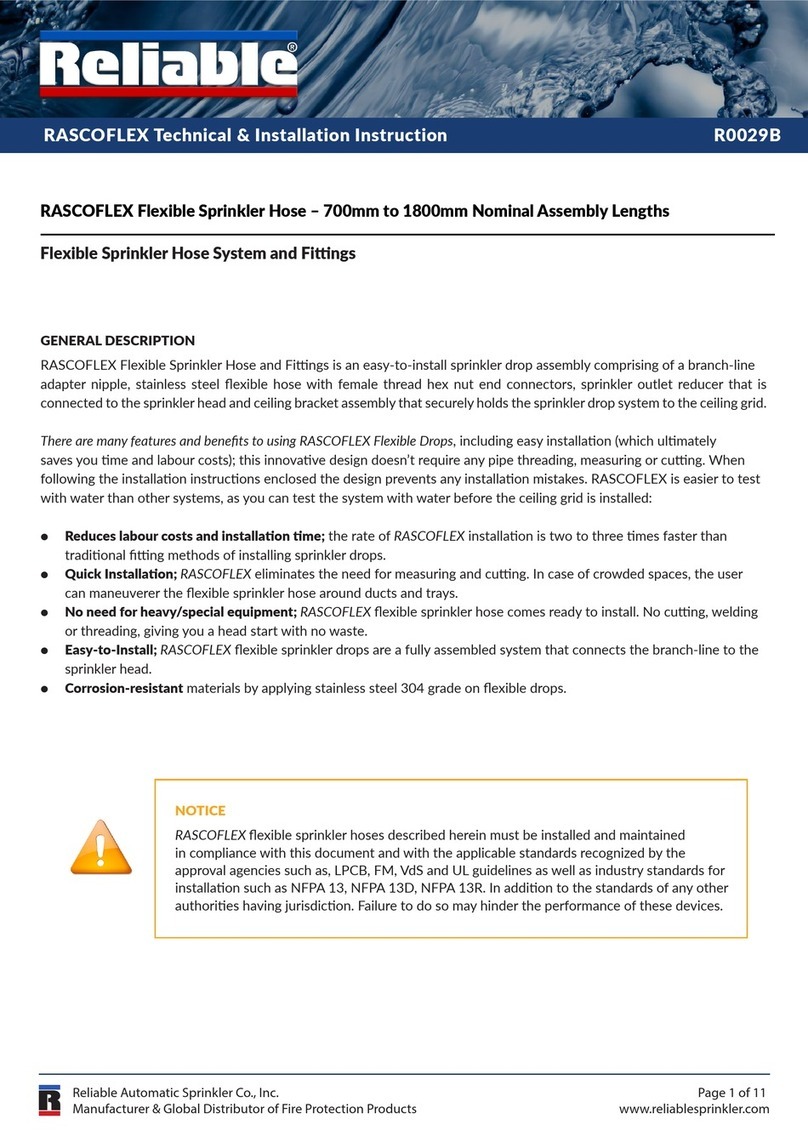
Reliable
Reliable R0029B User manual
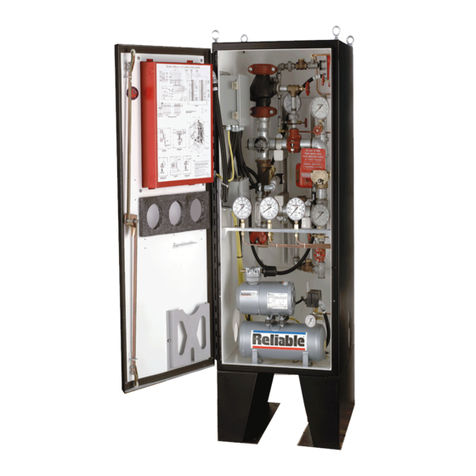
Reliable
Reliable H PrePak User guide

Reliable
Reliable H PrePak Maintenance manual
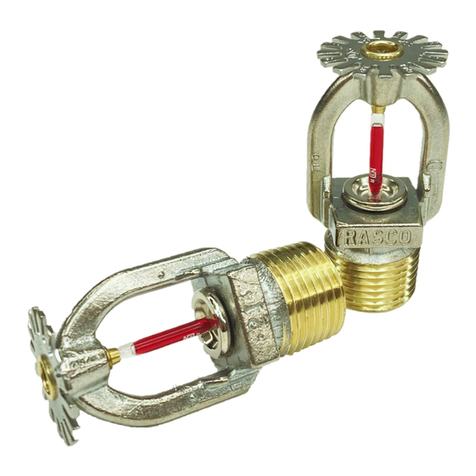
Reliable
Reliable F1FR56 User manual
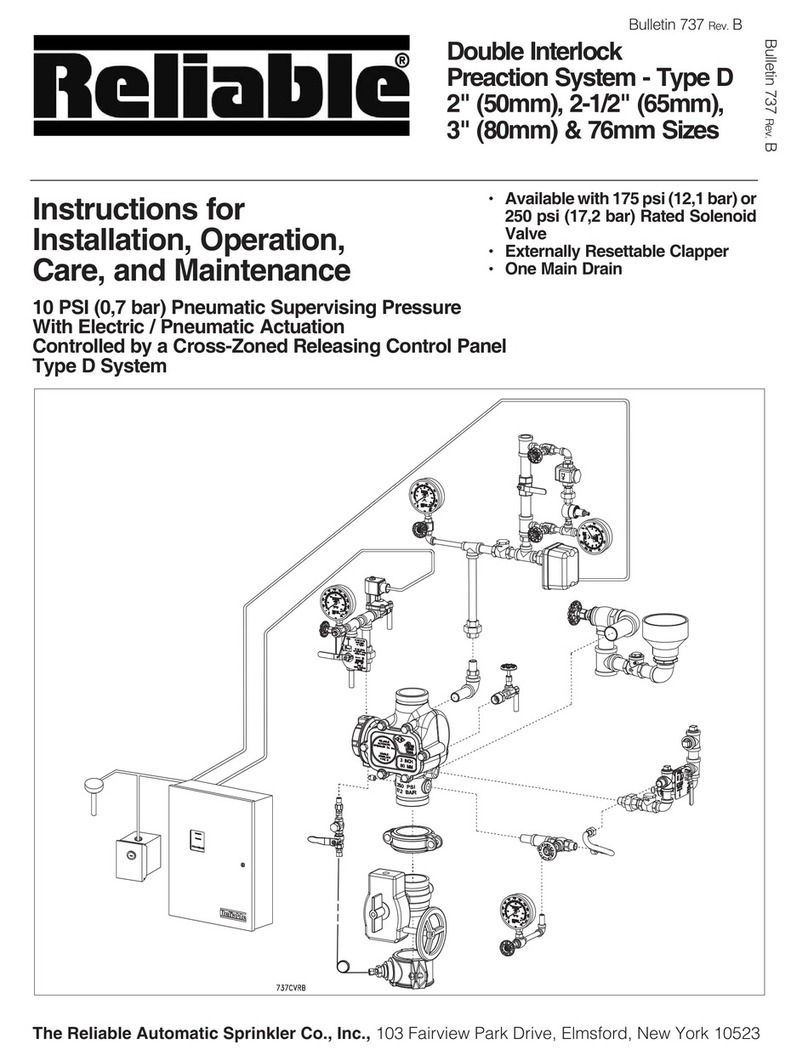
Reliable
Reliable Double Interlock Preaction System D Maintenance manual
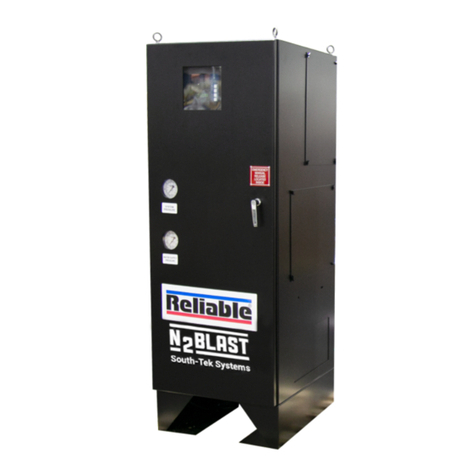
Reliable
Reliable N2-Blast DDX Maintenance manual
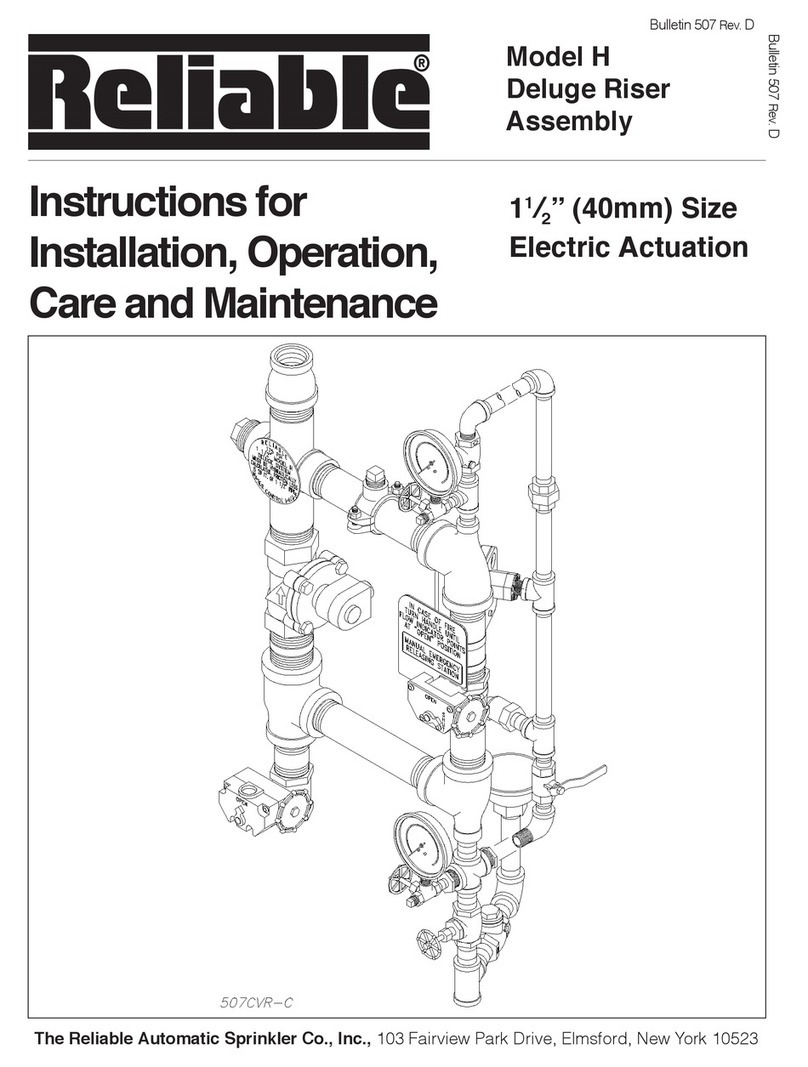
Reliable
Reliable H Deluge Riser Maintenance manual
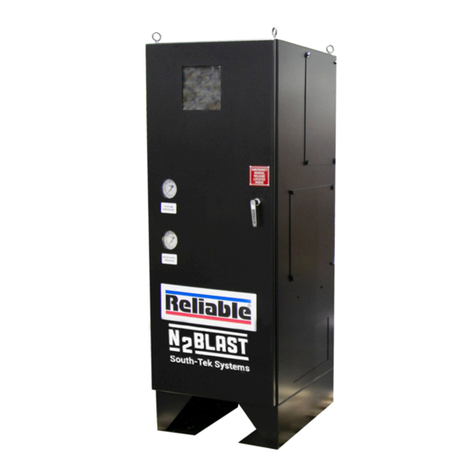
Reliable
Reliable N2-Blast DDX-LP PrePaK Maintenance manual

Reliable
Reliable N2-Blast DDX Maintenance manual
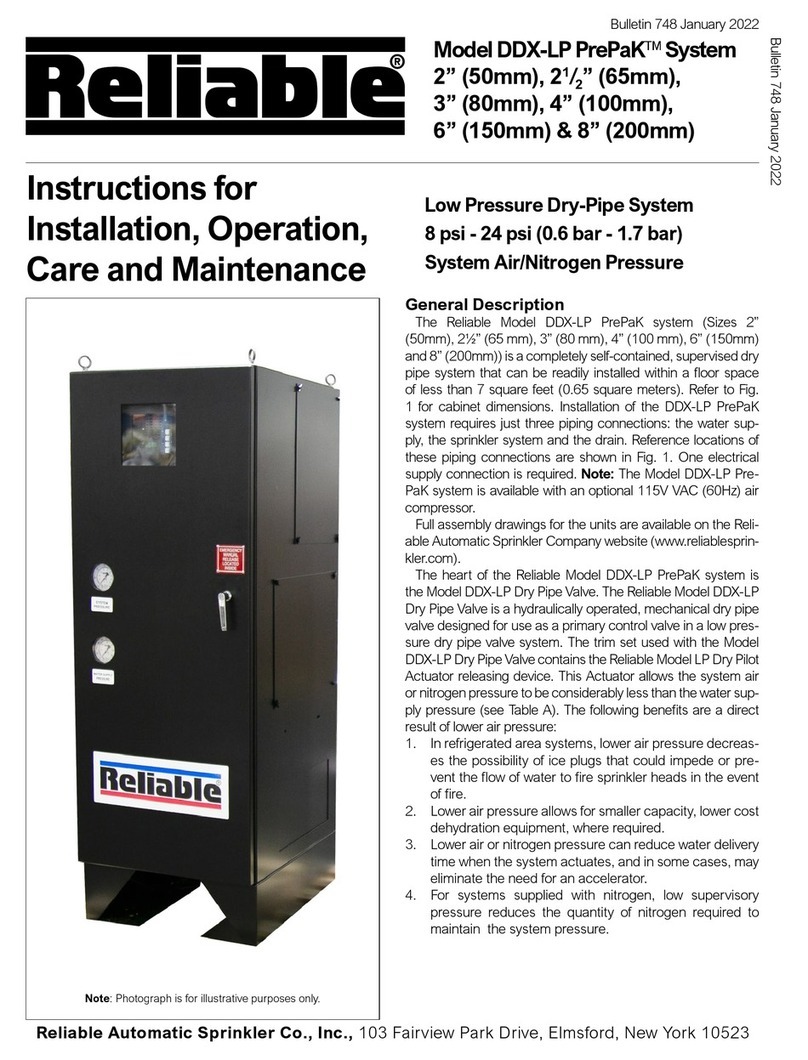
Reliable
Reliable DDX-LP PrePak Maintenance manual
